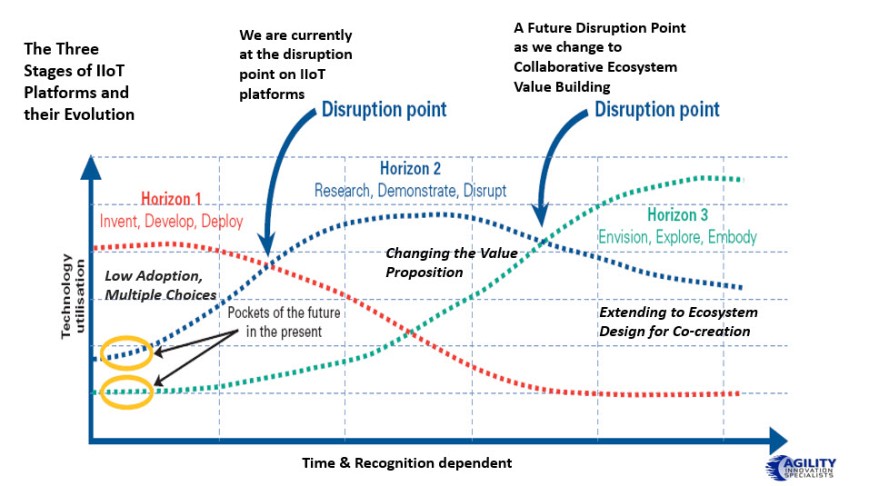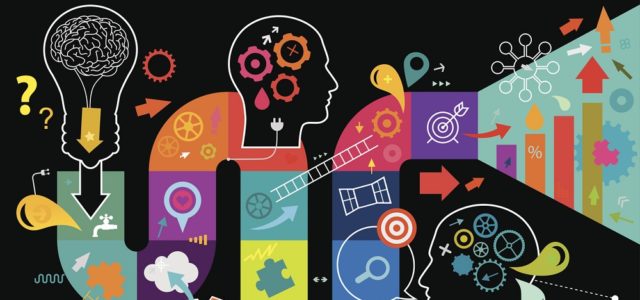In my opening post (here) I was thinking where platform providers seem to be, in their current value proposition. I cannot see their approaches as sustaining. Now, this is a personal opinion and observation but let me lay out an alternative view. I believe we are at an inflection point where the design of an IIoT platform needs to be integrated into a new way of Ecosystem Design.
There is a real need for a more shared value, breaking through the old traditional boundaries of single companies working with ‘selected’ providers of service and highly selective platform providers.
Ecosystem design is about being open in all potentially valuable proposals and co-creation possibilities. It is using multiple platforms as being part of a very different future design. You go where the best collaborations can take place not get .locked into one.
We need to stop and start to think about Ecosystems and their design for platform providers. Platforms have been amazing in their design, recognition, and value in a very short time. They are changing the way we undertake business. We have passed through the early phase of their design. It is now time to bring platforms into there place within a greater Ecosystem design.
Firstly you can read the opening post on this here
We need to evolve our present IIoT platform position. Otherwise, we see a possible scenario like the one shown below, unless there is not this recognition of change. A change from the IIoT partner attempting to dominate whereas it needs a balanced approach for greater collaboration and co-creation. It moves from one-with-one to many-to-many, through a specific platform hosted by the right IIoT platform provider.

My view of where we need to go:
Establishing an ecosystem of design allows a network of cross-industry players to work together through their chosen common platforms. It is the depth and breadth of the collaboration undertaken between the participates that can deliver a different value proposition to new consumer solutions, or extend necessary capabilities through the cooperations and discoveries that make together. To achieve this a technology platform is provided to facilitate this. It is suggested no single player needs to dominate or needs to own or operate all components of the solution. The value of this ecosystem generates solutions that when the combined parties collaborate, each of the parties involved, gain greater value beyond operating as a single entity.
Today’s platform providers I believe are missing this point. They want to offer their solutions, manage others data and their activities on their platform, they want to be the dominating player. I believe this will not work long-term.
The focus must be on the longer-term for multiple reasons
There needs to be a long-term solution of a very different value proposition and growth equation. It is the design of the ecosystem for all to extract value in greater opportunities for collaboration. Today’s offerings are very solution specific to each separate player. At present each platform provider is wrestling with taking from one and not providing the place or value proposition for collaborative sharing across a broader network. It is how all are participating and extracting multiple value points, holds the key to real sustaining differentiation.
I sit back and listen to all the very impressive partners on the supply side. These are a roll call of all the technology building companies like Amazon, Microsoft, SAP as well as all the Consultants (Deloitte, Accenture, PwC etc) all jostling in this space to carve out their piece or extract their revenue piece from clients.
Platforms are moving from being a radical design into being incremental. The distinctive parts are more a growing lead and lag, catching up or sneaking out a led, as different platforms providers catch up or find the next short-term competitive edge to nudge ahead. Is this where platforms are going, becoming commodity trading platforms?
Yet the game will be won or lost on the clients demand side. and this needs a fundamental shift in thinking.
This demand-side (clients) seems reluctant to jump on mass. That is partly because they (each client) see themselves as different in their issues and needs. There are constant ‘wins’ occurring as one platform provider beats another, to host that clients data and offer solutions for their data needs but it is so much more than this. This is presently a war of attrition, one client, then another, then move on. This is gaining ground at a high cost in investment, in channelling resources to achieve this.
Of course, one client’s need is very different to another, to get the platform ready and integrated into each operation is tough work in evaluations, in testing, in convincing, in connecting them up into the platform, to gain a return on resources.
Each customer needs to build a valid business investment case to convince the board to make the investments but it needs to be positioned as a far more future casting understanding of where the shift will head towards. One of greater collaborations, co-creation with multiple partners where a platform approach becomes essential.
Technology adoption is hard, hard work just to complete the analysis of best choice.
There is this promise of new sources of revenue, rationalizing cost structure and gaining value from this connecting up to be considered and offered as validation to the board to allocate funds and make strategic investments. Although it is claimed that there is ease in connecting into a platform, that is rather overhyped compared to the reality. When all sides sit down and begin to see the cost implications, the realities and the time it will take to get those returns, so easily spoken off by many, platform business validation still is a combination of a hard sell across organizations, still grappling with basic technology adoption.
There is a host of considerations. such as trustworthiness and reliability of the platform vendor, the security needs, and compatibility, what data resides where, the future development of solutions, of the platforms, of API’s that, actually work in a specific environment. Then you have scaling, adding machines, locations, overcoming legacies, how edge solutions will work in the real world of that specific client. No technology adoption through platforms is hard work.
Making choices are even harder. Do you chose Microsoft’s Azure, AWS IoT, IBM Watson, SAP Leonardo, PTC, etc., or do you go with specific manufacturers offering their “specialized” solutions? The likes of GE Predix, Siemens Mindsphere, Schneiders EcoStruxure, Bosch IoT Suite. You literally have hundreds, I mean hundreds of permutations to evaluate, no wonder the “hype” gets often to a fever pitch in sales pitches.
Then you as a CTO are required to gaze into a crystal ball on speed, on the rate of change, the levels of technology change occurring, and all the different tools that need to be considered to bring out improved performance. Do you build data centres or rely on third partners? How do you evaluate your Intellectual Property, what needs to stay resident, what can go up into a cloud? You need to convince a majority of board members who remain highly sceptical of this level of change, who keep asking for what level of real return.
I have seen it is suggested it will take about eight years to complete the transformation to a digital organization. One where any implementation, is to progressively invest, learn and then realize the potential of digital transformation. How returns are calculated on the investments made needs to be broken down, to gain constant validation along the way. That does seem a very long time but perhaps is realistic.
If this is the case then platform providers need to change their point of value.
Also, it still seems so many organizations do not even have a robust IT investment plan in place today, just space and approval enough to experiment, pilot. and learn. Many manufacturers lack a bold strategy within their IT solutions. IIoT Platform providers are running well ahead of the current adoption curve. A shift in the value proposition given to a client might need to change to adjust to this slow adoption curve. It might require a far more highly collaborative and imaginative set of solutions, beyond today’s offerings.
We need a clear story that relates to the clients’ need as the first step.
I am tired of listening to the claims that behind every platform (or we hope) is a dynamic web of technology-based partners who will handle everything. It seems it is not convincing the majority of non-adopters.
We know platforms are the way to go (so far in current wisdom) as platform-based business models we are told will be core to the future business strategy. How we overcome legacy systems and accelerate a new architecture on a scale and momentum requires much beyond the current rhetoric of Industry 4.0. So what is that story?
We need a focus on the client need not the IIoT platform providers need.
So my view of the three stages of IIoT platforms that we will be going through.
We are close to the first trigging point of disruption around IIot platform and what needs to move into the next phase of exploring and changing the value proposition

I would content it is to refocus away from the platform message onto the ecosystem one. Now the word “ecosystem” comes in multiple flavours and understanding. One part of our new story needs to define and structure a ‘real’ ecosystem that manages creation, evolution, and destruction.
Ecosystems are not today’s story of partners that ‘simply’ sell, deliver and service the offering’. It is mobilizing, creating, designing an ecosystem that is built on an open, shared value model.
First, you consider a framework of value co-creation.
I am a real admirer of Chris Lawer and his work on Ecosystem Value Design at Umio. He focuses specifically on the health industry but I know his work has a wider application, that is what is holding my interest. I keep as up to date on this as it is an essential part of knowing the new approach to building lasting and healthy ecosystems. It is part of the new story we need to shift towards.
Ecosystems are full of adoption or adaption, rapid growth, growing maturity and then this inevitable decline. It is how we build the new story around collaboration, knowledge exchange and networks. Each of these needs a new design or recognition that without these three we can’t change and re-equip ourselves to take digital advantage.
The new story needs to start here in recognizing open collaboration, knowledge exchanges, and networks, are our base. It is technology then needs to sit on top of these, as do many other enablers to facilitate this. We are designing presently around technology fit, not the client, or ecosystem fit. We need to change what is offered. This requires a new promise of value, growth, partnerships, and ability to deal with growing complexity in a highly secure and networked environment. The current messages are wrongly placed I feel. They focus on the IIoT provider, not the client and their increasing need of being in a network for co-creation and new growth paths.
We need to go back to the roots of Ecosystem understanding
The present use of the word “ecosystem” has been born or borrowed (for industrial use) from ecology but it is not appreciating the understanding as well as it should do. We in industry do need to understand this, embrace it and interpret it in this ecological way, or design the Eco-friendly intent in a clear, game-changing way, that allows us to move forward at higher increased rates of change.
To do this we do need new patterns of thinking, in our behaviours and the way we undertake business. New mental models are notoriously hard to adopt. Trust becomes central but this can be a different level of trust, built increasing on AI and a growing Charter of Trust. I actually listened to a fledgeling Charter of Trust while at Siemens but it is being built ‘just’ for dealing with Cybersecurity. Again technology-led not Ecologically-led. Perhaps it can evolve up as well as down? That is for another post perhaps.
So at this point in time, I believe IIoT platform providers have to change their business model
So content IIoT platform providers need to shift from their own positioning of controlling and owning platforms and their solutions. They should become increasingly open and work towards a greater ecosystem design.
Do I have a clearer picture of what is an Ecosystem design? It is emerging and needs a fleshing out, a depth of exploring and validation. I believe the current IIoT platform providers’ value proposition is wrong, pure and simple, based on their needs. I propose we need to urgently go to the next stage of the evolution design to accelerate adoption and move towards a greater ability to co-create, collaborate and network and the platform becomes essential for that to occur, within ‘given’ spaces.
Article by channel:
Everything you need to know about Digital Transformation
The best articles, news and events direct to your inbox
Read more articles tagged: Featured, Internet of Things







